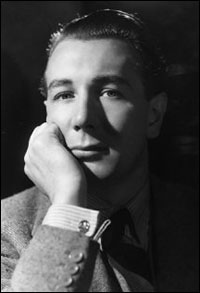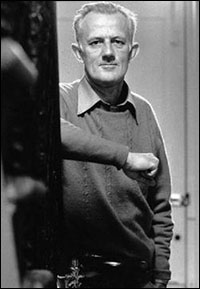
*
Tim Adler opens his new book with Laurence Olivier — not yet a Sir, just a Hamlet — interrupting curtain calls one night in 1937 to announce that "tonight a great actress has been born: Laertes has a daughter." The Laertes in question was Michael Redgrave, who the next year would achieve film stardom as the intrepid hero of Alfred Hitchcock's "The Lady Vanishes," and who himself would be knighted in 1959. The daughter in question was one Vanessa. With an introduction like that from one of the century's great Hamlets, the hours-old Vanessa was duly and properly launched.
This tale makes an arresting introduction to Adler's The House of Redgrave: The Secret Lives of a Theatrical Dynasty [Aurum]. As does his postscript to that night at the Old Vic, with the new father trundling off to bed with Edith Evans — who became a Dame before Larry or Michael became Sirs — and who was decidedly not Vanessa's mother nor Michael's wife. Which, as it turns out, is well-mannered behavior compared to the marital escapades of the various Redgraves with extramarital affairs all 'round. The only happy marriage we hear about, in fact, is that of Lynn. Who in 1998 discovered that her husband of 31 years was the secret father of her grandson, or something of the sort. And that's the best of the marriages.
For those who need a scorecard, the Redgrave dynasty — if you want to call them a dynasty — extends over three generations of stage and film celebrities. They are in turn descended from an earlier pair of actors, one of whom deserted six-month-old Michael and his mother and ran to Australia, where he formed a touring company and drank himself to death. Michael's mother, herself, was apparently the illegitimate daughter of yet another actor.
Michael (1908-85) married Rachel Kempson (1910-2003), whom he met in stock in 1934. While Kempson never achieved the fame of her husband, daughters, son-in-law, granddaughter or grandson-in-law — she was merely an accomplished actress — she had a long career, making her last appearance in 1997 (playing Vanessa's mother). Their three children were the infamous Vanessa, the merely famous Lynn (1943-2010), and the less-well known Corin (1939-2010). The latter shared his elder sister's radical tendencies, and seems to have sacrificed his career prospects in the process. The dynasty continued with Vanessa's daughters Natasha Richardson (1963-2009) and Joely Richardson (born 1965). *
Passionate about theatre books? See what the Playbill Store has on its shelves.
 |
||
| Michael Redgrave |
This book about all the Redgraves is a highly-readable page-turner which will keep your eyebrows in a semi-permanent state of raised. It is somewhat off-kilter, though; the family saga is hijacked by Tony Richardson, Vanessa's husband for six years (although he remained an integral part of the family for the rest of his life). I've not done a page-by-page count, but this Redgrave-by-marriage seems to get far more coverage than either Michael or Vanessa; he also seems to get more space than Rachel, Lynn, Corin, Natasha and Joely combined. It's almost as if the author started writing a biography of Tony until some publisher convinced him that adding the presently-more-famous Vanessa and Natasha would make the thing more salable. (There are so many Richardsons and Redgraves floating about that you'll excuse me for putting them on a first-name basis.)
This is not a negative. Tony was for a decade one of the most influential stage and film directors around, central to the "angry young man" movement that came out of Great Britain in the late 1950s. He made his name in London and on Broadway with John Osborne's Look Back in Anger, The Entertainer (starring Laurence Olivier) and A Taste of Honey. The film versions of these helped shake up the British cinema, with Richardson in 1963 reaching his pinnacle — and winning best director and best producer Oscars — for the phenomenally successful "Tom Jones." (Nepotism is fine when you have talented relatives. "Tom Jones" featured mother-in-law Rachel and sister-in-law Lynn, while Michael starred in Tony's prior film, "The Loneliness of the Long Distance Runner.")
What's more, Tony's private life was as eyebrow-raising as Michael's. When this book was initially serialized in the Daily Mail in 2011, Vanessa objected to the statement that she once discovered her husband and her father — well, let's just say that she objected and the sentence does not appear in the published book version. Adler does report, though, that during a summer vacation in Nice with Vanessa, Tony and Michael together attended one of Terrence Rattigan's "all-male parties."
* Passionate about theatre books? See what the Playbill Store has on its shelves.
 |
||
| Tony Richardson |
Reading between the lines, it appears that Adler — a journalist specializing on the film industry, with two prior Hollywood books — was a school chum of Natasha. He spoke with her about the book before her death in 2009, and broached the idea with Vanessa. The latter ultimately determined that the family would not cooperate on the project. No wonder, as things turned out. The book offers footnotes, but woefully few — leaving one to wonder just where the author is getting his (often juicy) information.
The 300 pages are unceasingly readable, although the reader might have some qualms. There is an unevenness, as suggested above; Tony constantly steals focus from all those Redgraves. Adler also displays a lack of understanding of things American, which wouldn't be such a problem if so much of the combined careers didn't take place over here. (More than half of the Redgraves — Tony, Rachel, Lynn and Natasha — moved to, and died in, America.)
Josh Logan, for example, is identified solely as a "Hollywood director." Adler tells us that the only name Warner Bros. could come up with for leading lady of the film version of Camelot was Julie Andrews, without apparently understanding why. And most curiously, Lehman Engel turns up at Corin's home in London on Oscar Night 1967 — when Vanessa ("Morgan") and Lynn ("Georgy Girl") both lost to Elizabeth Taylor for "Who's Afraid of Virginia Woolf?" — and precipitates a major crisis in the lives of Michael and Corin. But Lehman, the legendary Broadway musical director who had more Tony Awards than Michael, Vanessa, Lynn and Natasha combined, is identified by name only.
The merry Redgraves surely don't compare to the Barrymores or the Lunts, as royal acting families go. But "The House of Redgrave" — comingled with the house of Richardson — offers an enlightening snapshot of a fascinating but difficult clan. (Steven Suskin is author of the updated and expanded Fourth Edition of "Show Tunes" as well as "The Sound of Broadway Music: A Book of Orchestrators and Orchestrations," "Second Act Trouble," "A Must See," the "Broadway Yearbook" series and the "Opening Night on Broadway" books. He also pens Playbill.com's On the Record and The DVD Shelf columns. He can be reached at [email protected].)
*
Passionate about theatre books? See what the Playbill Store has on its shelves.










